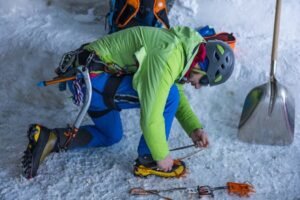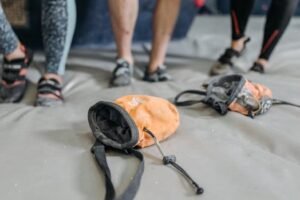What Is a Bouldering Crash Pad and Why You Still Need to Spot Your Friends
If you’re reading this, chances are you’re already a climber—or at least curious enough to know what really matters when it comes to safe outdoor bouldering. A lot of people know about some climbing equipment but not everyone knows what a bouldering crash pad is, but if you’ve ever fallen off a boulder problem, you know just how crucial one can be. Still, let me be clear: having a crash pad is not everything. The truth is, even with the biggest, plushest mat beneath you, if no one’s spotting you, you’re still at risk of a bad landing. And trust me, I’ve seen enough twisted ankles and busted wrists to know that first-hand.
Table of Contents
ToggleSo, What Exactly Is a Bouldering Crash Pad?
A bouldering crash pad is a portable foam mat designed to absorb the impact of a fall while bouldering. These pads are essential pieces of gear for any boulderer who climbs outside. Since bouldering typically involves climbing low-height problems (usually up to 15 feet or so) without ropes, the crash pad is your main protection when you fall. Think of it as your safety net—but on the ground.
It’s built with dense foam layers to cushion your landing. Usually, a crash pad folds in half or in thirds, making it somewhat portable (though still a bit of a pain to lug around). They come with backpack-style straps so you can carry them from one boulder to another, and often include extra features like gear pockets or Velcro closures to keep them folded up tight.
 Ocun Dominator FTS Bouldering Crash Pad
Ocun Dominator FTS Bouldering Crash Pad
The Ocun Paddy Dominator is a premium Bouldering crash pad designed for serious boulderers who want top-tier climbing gear—with advanced impact absorption and foldable convenience for safer landings.
 Metolius Session Bouldering Crash Pad.
Metolius Session Bouldering Crash Pad.
The Metolius Session II crash pad offers solid protection and easy transport—perfect for outdoor boulderers looking to upgrade their climbing gear with reliable impact support and durability.
 PETZL Bouldering Crash Pad
PETZL Bouldering Crash Pad
The PETZL Cirro bouldering crash pad offers premium impact protection with triple-layer foam, a durable cover, and an innovative folding system—perfect for serious boulderers seeking safety and comfort.
 BEEMAT Caley Bouldering Crash Pad
BEEMAT Caley Bouldering Crash Pad
The BEEMAT bouldering crash pad delivers high-density foam cushioning and a durable PVC cover, offering reliable protection and comfort for climbers tackling demanding bouldering problems.
 Widdop Bouldering Crash Pad
Widdop Bouldering Crash Pad
The BEEMAT Ultralight bouldering crash pad is designed for portability without compromising safety, featuring lightweight construction and reliable foam padding for everyday bouldering adventures.
Types of Bouldering Crash Pads
There are several types of crash pads out there, and depending on your climbing style, the rock type, or even your vehicle size, one might suit you better than another. Here’s a quick breakdown:
1. Standard Crash Pads
These are your average-sized pads—usually around 3×4 feet when unfolded. They fold in half like a taco or book and are the go-to for most climbers. Good balance between size and portability.
2. Taco-Style Pads
These pads don’t have a hinge; instead, the foam folds in one big curve, like a taco shell. The benefit is you won’t land directly on a crease, which can happen with hinged pads. The downside? They’re bulkier and harder to store.
3. Hinged Pads
These pads fold more neatly and flat, thanks to a hinge down the middle. Easier to carry and store, but beware: landing right on the hinge can sometimes be risky if the seam splits or collapses a little.
4. Oversized Crash Pads
These are large-format pads, great for highballs or for covering a lot of uneven terrain. The bigger, the better—until it comes time to shove it in your car. But honestly, if you can bring it, it’s worth it.
5. Supplementary Pads (Slider Pads)
Small and thin, these are great for covering gaps, sharp rocks, or extending protection. They’re not enough on their own, but they work wonders when paired with bigger pads.
The Bigger the Better… But Let’s Be Real
I’ll say it: the bigger the bouldering crash pad, the better. If it were up to me, I’d bring two every time. But realistically, many of us climb in groups, and not everyone’s driving a van or SUV. That’s why I believe if more people bring their own crash pad, we can collectively build a safer landing zone.
It’s about teamwork. Bring your pad, contribute to the landing setup, and you’re making it safer for everyone involved. A single crash pad is rarely enough, especially on uneven or sloped terrain where the risk of a fall is more unpredictable.
Spotting: The Underrated Art of Climbing Support
Now let’s talk about something that often gets ignored but absolutely shouldn’t: spotting. Just because there’s a bouldering crash pad under the climber doesn’t mean you get to sit back and scroll through your phone.
Spotting isn’t about catching someone. It’s about guiding their fall so they land feet-first, safely on the pad, and not with their neck or back twisted over a rock. You’re there to move the pad if needed, support their hips or back during a sketchy move, and make sure they’re not falling into a dangerous area.
I’ve seen more injuries from poor spotting—or no spotting—than from any other reason out at the crag. And it’s frustrating because it’s so preventable. Just staying alert and having your hands up can be the difference between a safe fall and a trip to the ER.
Crash Pads Don’t Replace Common Sense
Remember, a bouldering crash pad is just one piece of the safety puzzle. It won’t protect you if it’s not placed properly. It won’t do anything if you land off the edge. And it certainly won’t help if your friends are off filming Instagram stories instead of watching your climb.
Climbing outdoors is about more than just the moves; it’s about community and responsibility. When you go out bouldering, you’re part of a team—even if you just met that crew that morning. Share the load, carry your own crash pad, and most importantly, keep an eye out for one another.
Because let’s face it: even the best landing zone won’t save you from a fall gone wrong without someone there to guide you down.
Action Sports Equipment Blog Post List
- Best Football Boots Without Laces in 2025: Clean Strikes & Comfort
- Top 5 Football Drills at Home to Improve Your Skills
- The Best Climbing Training Plan
- What Is a Bouldering Crash Pad and Why You Still Need to Spot Your Friends
- Why Intermittent Fasting Works And Why Zero Calorie Drinks Are So Important
- The Best Supplements for Muscle Growth That Have Changed My Fitness Journey
- Padel Tennis Court Size: Understanding the Dimensions and Rules of the Game
- Most Popular Climbing Chalk Bag
- Beginner’s Guide to Choosing the Perfect Rock Climbing Harness in 2025
- How to Chose the Best Padel Rackets
- The Ultimate Guide to Choosing the Best Padel Shoes: A Comparison of Top Amazon Picks
- 10 Fitness Motivation Quotes to Ignite Your Workout Fire: Stay Inspired and Empowered
- Find your best freestyle football ball
- Starting Your Running Journey? Here's How to Pick the Best Running Shoes for Beginners
- The Best Folding Treadmills for Home
- Football GPS Tracker




